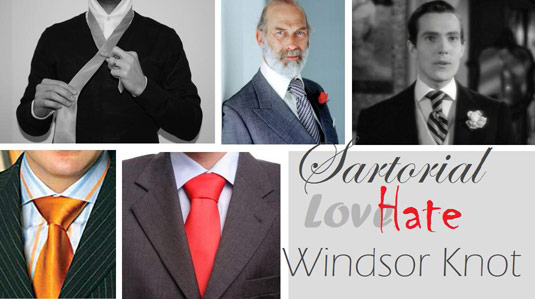
One of the most interesting comments I receive about my clothing is that for such an ostentatious person, my tie knot is perplexingly small. Puffs of silk; colour matching and contrasting; texture complementing and yet such a tiny knot. “I thought” new acquaintances often mumble “you’d wear a big Windsor knot.”
I used to be a fan of the Windsor. Whilst at school, I trained myself to tie the perfect version and was very conscious at social functions about my knot and the knots of others. It made sense that I should be so faithful, for I was a speedy devotee of the cutaway collar which, because of its wide spread, is considered to be more befitting of an enormous Windsor ‘doughknot.’ I was eventually turned against the alarming size by reviewing photographs of myself, an emaciated youth, with a thin neck and a fat knot; it was an unattractive contradiction that made the tie look heavy and simplistic. I surfed around for a style that I did not find so visually revolting and settled on the four-in-hand which I now tie, like my father, into a smallish knot.
The Windsor is no worse for my rejection of it; it is simply everywhere. Perhaps it is the name, the royal connection or the popularity of cutaway collars but it seems the Windsor knot has never been more popular. I trawled through Lewin’s sale selection recently and my companion was shocked at my approval of the new St James collar, the most extreme cutaway Lewin has produced to date, and, mystified, asked me “Don’t you have to wear an enormous knot?” I was equally confounded; “What on earth for?” He replied earnestly “You know? To fill the space? Otherwise you see the bits either side.”
If you tie a tie properly and wear the right collar size, you shouldn’t see ‘the bits’ either side of any knot. Prince Charles, for example, is fond of smaller knots and wider collars and manages to tie a tie without any ‘bit’ exposure. Firstly, he knows that the tie should be secured to the top rather than the middle or bottom of a collar, and that the ‘bits’ are correspondingly squeezed into the crevasse under the ridge of the collar. I choose this style because I believe that it averts attention from that area; the Windsor, so noticeable in size, attracts attention and this means I spend a great deal of time looking at people’s chins which is not a pleasant pastime.
However there are those who wish to attract attention to their neckwear and to remove the ‘presentation’ from their silk is simply not an option; the Windsor is a presentation knot, one for men of confidence and self-consciousness. These men do not wish to be seen to be strangled in an attempt to convey subtlety. They believe in proportion and it confuses them that others can be so generous in tie width and yet so mean in tie knot.
The Windsor is frequently cited as the most comfortable of knots, remaining tightly tied whilst still allowing ‘breathing room’ between the collar and neck. For me this is it’s main benefit, and I do concede that certain people, for example Prince Michael of Kent, wear it very well but those who experiment with it tend to overegg it rather which results in something that looks less like a cravat of royalty and more like an attempt of a sartorially illiterate footballer. I think the key is to follow the aesthetic of Hurd Hatfield and HRH in the pictures above (top right); make the knot more conical than triangular (see bottom left) – and do not flatten the wretched thing (bottom centre).








